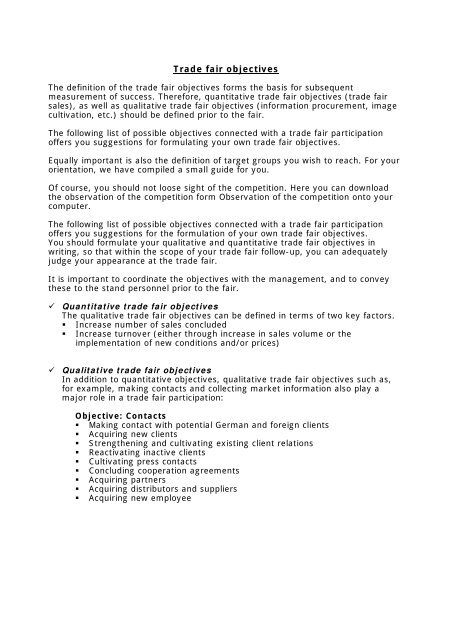Trade fair objectives - Spoga+Gafa
Trade fair objectives - Spoga+Gafa
Trade fair objectives - Spoga+Gafa
You also want an ePaper? Increase the reach of your titles
YUMPU automatically turns print PDFs into web optimized ePapers that Google loves.
<strong>Trade</strong> <strong>fair</strong> <strong>objectives</strong><br />
The definition of the trade <strong>fair</strong> <strong>objectives</strong> forms the basis for subsequent<br />
measurement of success. Therefore, quantitative trade <strong>fair</strong> <strong>objectives</strong> (trade <strong>fair</strong><br />
sales), as well as qualitative trade <strong>fair</strong> <strong>objectives</strong> (information procurement, image<br />
cultivation, etc.) should be defined prior to the <strong>fair</strong>.<br />
The following list of possible <strong>objectives</strong> connected with a trade <strong>fair</strong> participation<br />
offers you suggestions for formulating your own trade <strong>fair</strong> <strong>objectives</strong>.<br />
Equally important is also the definition of target groups you wish to reach. For your<br />
orientation, we have compiled a small guide for you.<br />
Of course, you should not loose sight of the competition. Here you can download<br />
the observation of the competition form Observation of the competition onto your<br />
computer.<br />
The following list of possible <strong>objectives</strong> connected with a trade <strong>fair</strong> participation<br />
offers you suggestions for the formulation of your own trade <strong>fair</strong> <strong>objectives</strong>.<br />
You should formulate your qualitative and quantitative trade <strong>fair</strong> <strong>objectives</strong> in<br />
writing, so that within the scope of your trade <strong>fair</strong> follow-up, you can adequately<br />
judge your appearance at the trade <strong>fair</strong>.<br />
It is important to coordinate the <strong>objectives</strong> with the management, and to convey<br />
these to the stand personnel prior to the <strong>fair</strong>.<br />
! Quantitative trade <strong>fair</strong> <strong>objectives</strong><br />
The qualitative trade <strong>fair</strong> <strong>objectives</strong> can be defined in terms of two key factors.<br />
" Increase number of sales concluded<br />
" Increase turnover (either through increase in sales volume or the<br />
implementation of new conditions and/or prices)<br />
! Qualitative trade <strong>fair</strong> <strong>objectives</strong><br />
In addition to quantitative <strong>objectives</strong>, qualitative trade <strong>fair</strong> <strong>objectives</strong> such as,<br />
for example, making contacts and collecting market information also play a<br />
major role in a trade <strong>fair</strong> participation:<br />
Objective: Contacts<br />
" Making contact with potential German and foreign clients<br />
" Acquiring new clients<br />
" Strengthening and cultivating existing client relations<br />
" Reactivating inactive clients<br />
" Cultivating press contacts<br />
" Concluding cooperation agreements<br />
" Acquiring partners<br />
" Acquiring distributors and suppliers<br />
" Acquiring new employee
Objective: Market information<br />
" Information about state of the sector<br />
" Observation of the competition (information about price and product<br />
policy of competitors)<br />
" Monitoring of competitiveness<br />
" Requirements of the target groups consumer behaviour<br />
" Reactions of the target group to innovations<br />
" Identification of market niches<br />
" Information about innovations and market trends<br />
" Export opportunities<br />
! Target groups<br />
The definition of the target groups who want to address with your products can<br />
be deduced from the trade <strong>fair</strong> <strong>objectives</strong>. Target groups are, among others,<br />
end-consumers, wholesalers and retailers, sales agents, suppliers, press and<br />
public.<br />
The communication concept (advertising message, advertising material, and<br />
composition of the <strong>fair</strong> team) should be designed according to the defined target<br />
group.<br />
" Advertising message<br />
The advertising message must promise the buyer a benefit and/or a<br />
service which is unique. Information about the product must be designed<br />
dependent on target groups, i. e. while the information should be simple<br />
and easily understandable for the end-consumer, information for buyers<br />
should contain many technical details.<br />
" Advertising material<br />
You should fundamentally consider which advertising material (brochure,<br />
leaflet, photos of exhibited products, etc.) you want to use at a trade <strong>fair</strong>.<br />
The content and look of the chosen advertising material should meet the<br />
requirements of your target group.<br />
" <strong>Trade</strong> <strong>fair</strong> personnel<br />
The trade <strong>fair</strong> team members should also be chosen dependent on the<br />
target group. If you want to make contact with new suppliers, it would be<br />
advisable to take members of the buying department with you to the<br />
trade <strong>fair</strong>. On the other hand, for complicated, technical exhibits, it is<br />
advantageous to have several members of staff from research and<br />
development present on the stand in order to explain them.<br />
! Monitoring trade <strong>fair</strong> success<br />
To monitor trade <strong>fair</strong> success means calculating the profitability of a trade <strong>fair</strong>,<br />
recording contact costs and comparing the company´s trade <strong>fair</strong> participations<br />
over years. This information is an important criterion for deciding on<br />
participation at future <strong>fair</strong>s.<br />
If you want to know how successful your appearance at a trade <strong>fair</strong> actually<br />
was, it is not sufficient to concentrate solely on sales. Instead, indices for<br />
monitoring trade <strong>fair</strong> success must be drawn up. In this connection, the basis of<br />
all success monitoring is the systematic recording of contacts with the aid of a<br />
trade <strong>fair</strong> report.
Observation of the competition<br />
At the trade <strong>fair</strong>/exhibition<br />
Name of competing company:<br />
Type of stand, size and number:<br />
Comments on stand design:<br />
Exhibited products and services:<br />
Are there new products? ❑ yes ❑ no<br />
If yes, which?<br />
Stand activities: ❑ yes ❑ no<br />
If yes, please briefly describe these stand activities:<br />
Promotion activities outside the stand ❑ yes ❑ no<br />
If yes, please describe briefly:<br />
Number of personnel on the stand:<br />
Stand was well attended: ❑ yes ❑ no<br />
If yes, approximately how many visitors?<br />
Brochures/information material: ❑ yes ❑ no<br />
If available, please take!<br />
Particular comments:<br />
Strategic relevance for own company:<br />
Employee name:<br />
Date and time:









